Vietnam is launching a campaign name "Live fully in Vietnam" as it welcomes international tourists back into the country.
Vietnam: Four seasons of travels
When you are a true traveller who travels for travel’s sake, you’ll encounter uncountable surprising experiences on your journeys. This may means that you’ll miss the few special days of the year when your destination is at its best.
It is perhaps for that reason, that beaches are always crowded in summer, and cherry blossoms gardens always mesmerise visitors in the spring. You can visit the West of Vietnam year-round, but the best time is the flood season. Planning your travels to fit the four seasons is important to have the perfect trip. Below are some of FantaSea suggestions of which are the most beautiful places in Vietnam to visit during each season.
Spring
Thanks to its geography and location, half of Vietnam – from Hue to the North – experiences the four seasons, while the South only has two: the rainy and dry season. Spring brings life and colours, as fields of flowers bloom after a long winter. Therefore, spring is the perfect time to visit the North, especially Ha Giang, Moc Chau or Sin Ho, Bac Ha to experience the wonderful nature and the warmth of the people. There are also hundreds of festivals held in the spring that you can join.
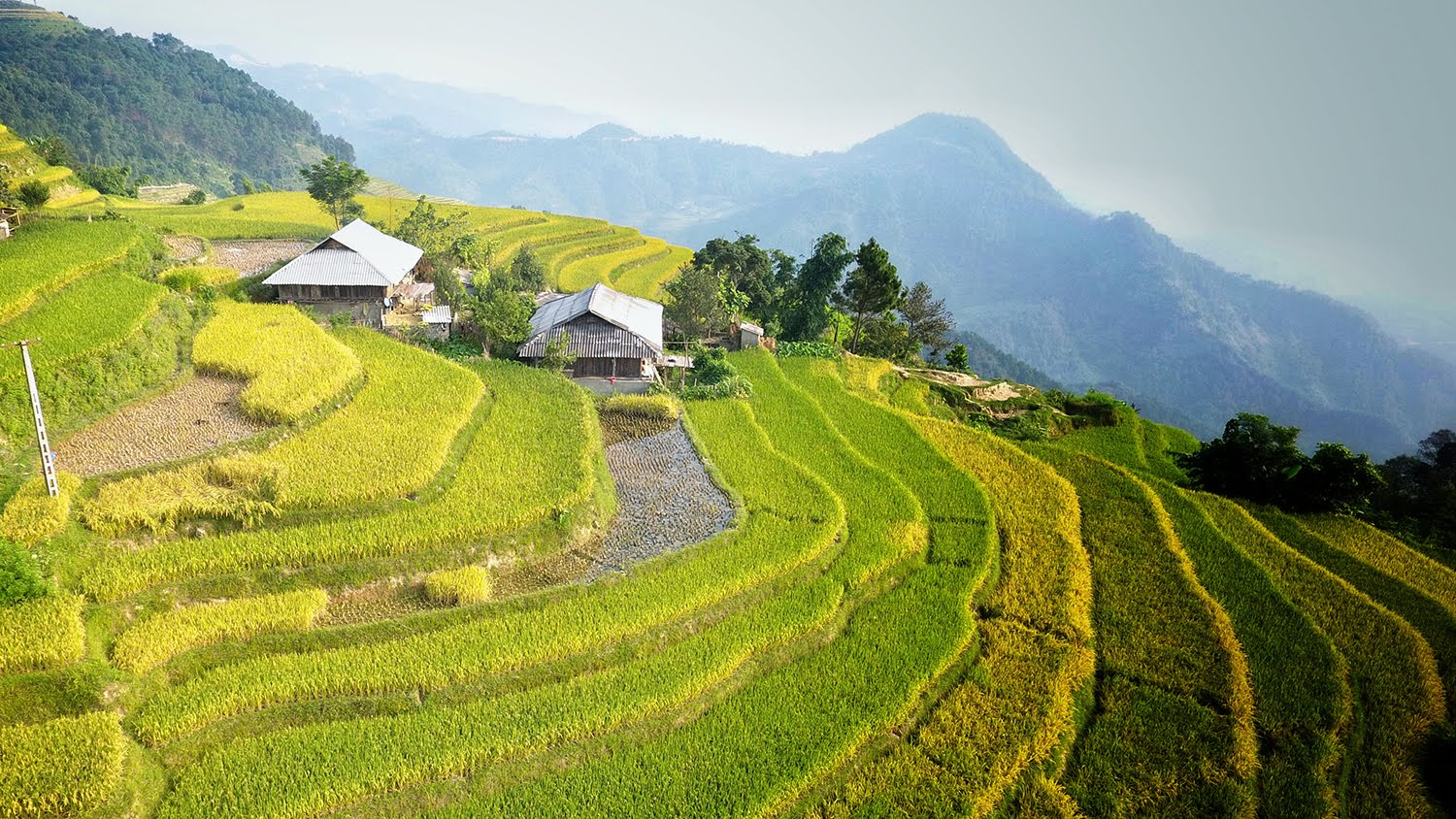
If you visit Ha Giang – Vietnam’s Northernmost province– in the spring, you’ll never forget the love markets immersed in the sounds of the H’mong’s panpipes, or the image of old ladies weaving linen by their doorsteps, in front of their dirt houses with tiled roofs that have yellowed over time. You’ll remember the sounds of the leaflute echoing in the forest and the mountains, which make travellers linger. A few pink-cheeked children play badminton with makeshift rackets made from wood panels. Sounds from the wooden fish (percussion instruments) playfully bounce off the grassy hillsides.
There’s nothing more beautiful than spring in Ha Giang Province. The earth and the skies put on a new outfit, made colourful by the red of peach blossoms, the white of apricot and plum blossoms, the pink of buckwheat flowers and bright with the colours of daisies. Young women work among the golden parsnip fields, the fog of winter has left, and the sweet smell of rice wine fills the village. The colours of nature fill the houses, the roads, and everything else in Ha Giang in the spring. One must praise the local H’mong and Dao people for interspersing the plantation of plums, peach, pear, and parsnip in their gardens to brighten up the rugged mountains and creating a beautiful natural picture that comes alive every spring.
Moc Chau is also a must-visit in the spring. Rather than majestic ragged mountains like in Ha Giang, Moc Chau is appreciated for its vast valleys filled with plum and peach blossoms. Hillsides are bright with white radish flowers and gold sunflowers, creating the perfect backdrop for the colourful outfits of the H’mong women. Thanks to its poetic landscape, Hua Tat Mountain, for generations, has been a meeting place for couples.
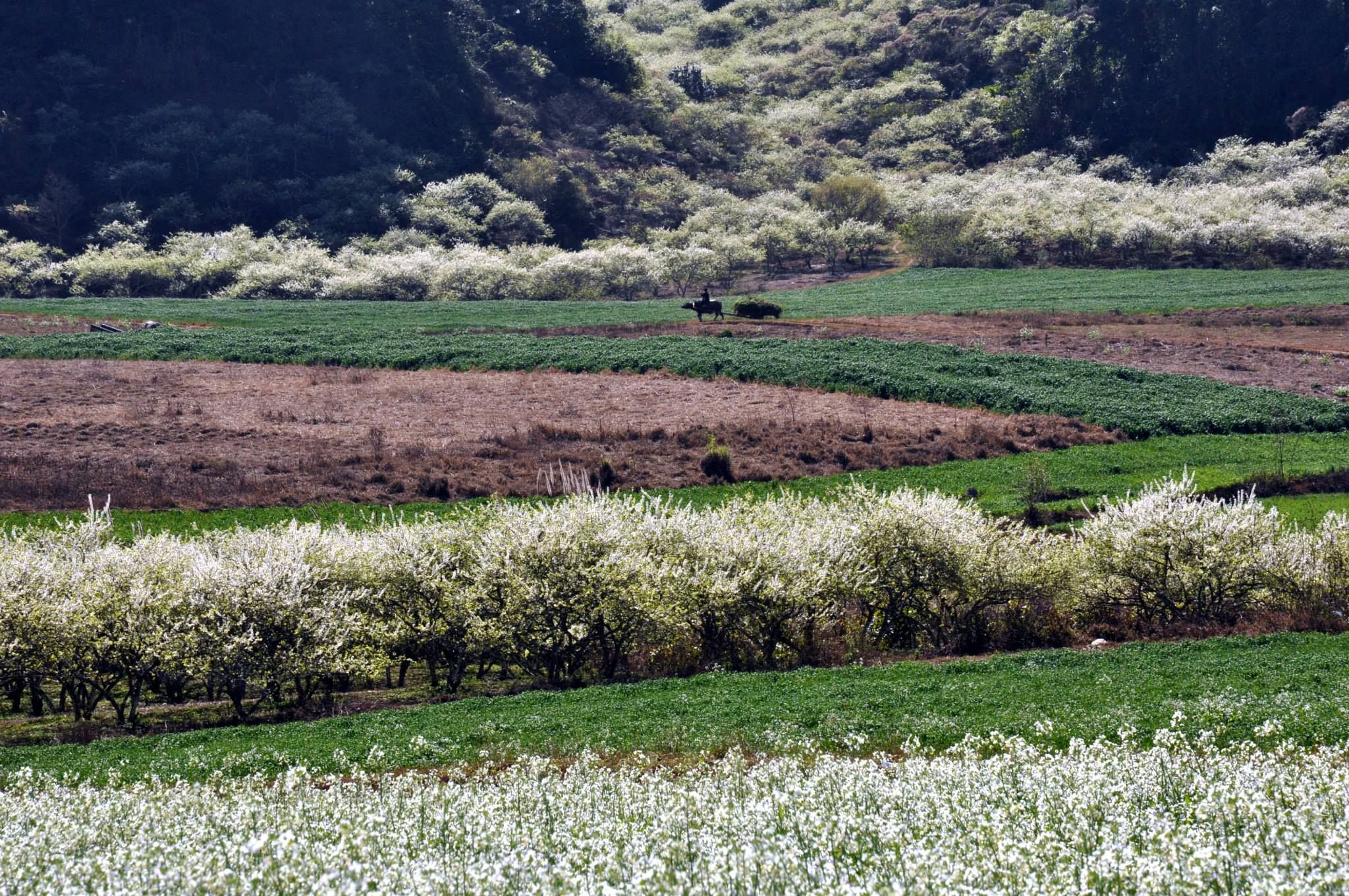
Moving South to Tay Nguyen, spring blesses the hills with white coffee flowers, filling the Highlands with a sweet and exotic scent. Don’t miss the sun-filled roads and the amazing culture and traditions in this place. From Danang, head down to Kon Tum towards Sea Lake before getting to Buon Me Thuot. Here, you can dance to the sounds of gongs filling the villages every spring. From here, head down to the dreamy Dalat or head East to visit the beautiful beaches of Central Vietnam.
+ Itinerary: Hanoi – Tuyen Quang – Ha Giang – Quan Ba – Yen Minh – Dong Van – Ha Giang – Hanoi.
+ Transportation: From Danang, Saigon or other provinces, you’ll need to travel (via plane, train, bus, motorbike or cars) to Hanoi and head to Ha Giang from there. The best time to visit Ha Giang is from the end of December to February. You can book flights 2 – 3 months prior to your travels or wait for promo offers by airlines.
The roads to the Rock Plateau of Ha Giang has been widened, hence legendary passes like Bac Sum, Ma Pi Leng or Tham Ma Slope are not too difficult to pass. From Hanoi to Ha Giang, you can travel by bus, motorbike or personal car. If you’re travelling by car, you can follow Noi Bai – Lao Cai Highway, turn at the IC4 intersection toward Tam Dao, and then follow the National Highway 32C to Son Duong, Tuyen Quang, and then Ha Giang Province. Avoid the Viet Tri Route as it is more crowded and takes longer. If you’re taking a public bus, there are many sleeper buses from My Dinh Station leaving from 8 to 9 p.m. and reaching Ha Giang City around 4 – 5 a.m. Here, you can rent a motorbike, car or bus to visit the surrounding attractions.
+ Attractions: Ha Giang has many hotels and guesthouses for tourists. There are also homestays, which you can find in Ha Thanh or Nam Dam Villages, such as Auberge de Meovac or Giac Xua.
+ Shopping and dining: Visit during the weekends to get a taste of the local culture at local weekend markets: Quyet Tien Market (Quan Ba) takes place on Saturday mornings, Dong Van Market takes place on Sunday mornings, Sa Phin Market takes place on days of the snake and the pig, Pho Cao Market takes place on the days of the dragon and the dog, Lung Thin Market takes place on the days of the tiger and the monkey. Some delicious dishes that you should try in Ha Giang are horse meat stew, corn wine, stewed corn, corn dumplings, five-colour sticky rice, buckwheat cake and buffalo meat.
+ 3 days in Ha Giang:
A 3-day weekend is just enough time for you to explore Ha Giang Rock Plateau. If time allows, you can wander around this fairy-tale land for a month without getting bored.
♦ Day 1: Ha Giang – Quan Ba – Yen Minh – Dong Van (155 kilometres). Some attractions on this journey are Quan Ba Heaven Gate, Tam Son Mountain, Lung Khuy Cave, Bac Sum Slope, Yen Minh Pine Forest, Fox Street, Sung La Valley and Home of Pao, Sa Phin Village – home of the H’mong King Vuong Chi Sinh, and Dong Van’s Old Quarter.
♦ Day 2: Dong Van – Lung Cu – Dong Van – Meo Vac (100 kilometres). The main attractions are Lung Cu Flag Tower – the Northernmost point of the country, Lung Tao, Ma Le, Sa Phin, Ma Pi Leng Pass and Meo Vac.
♦ Day 3: Meo Vac – Yen Minh – Quan Ba – Ha Giang (150 kilometres) or Meo Vac – Niem – Bao Lam – Bac Me – Ha Giang. You can also visit Cao Bang to see Ban Gioc Waterfall by following the route via Meo Vac – Niem Son – Bao Lac – Tinh Tuc – Cao Bang – Ban Gioc – Hanoi (which will take an extra day or two).
Summer
A summer paradise entails long smooth white sand beaches under the blue sky and sunshine. Nature has blessed Vietnam with a long coastline with romantic beaches and dozens of paradise islands. On summer afternoons, you can lie on the beach or swing in a hammock and listen to the love song of the ocean, take in the salty wind and indulge in a seafood feast.
This summer, Co To Island is expected to attract visitors from Northern Vietnam, thanks to its unspoiled landscape full of endless white sand beaches bordered by the blue sea. The journey from on land to the island is an interesting experience, as it passes Bai Tu Long Bay and the infamously scenic Ha Long Bay before reaching this paradise island.

In the Central Region, Lang Co Beach is a spectacular natural touch at the foot of the beautiful Hai Van Mountain Pass. Here, Hue’s royal court cuisine is bound to mesmerise visitors. Coming down to Danang, you can visit the endless green Son Tra Peninsula or the pristine An Bang Beach before heading to Hoi An for some tranquillity. Ly Son Island certainly will attract more visitors, with To Vo Arch, But Beach, the beautiful blue sea and its famous specialty: garlic.
From Quang Ngai to Vung Tau you can visit dozens of pristine beaches, where tourism is not yet over-developed. The exotic cultures in coastal fishing villages add flavour to your travels. You can see the street art at Tam Thanh Mural Village, which features dozens of colourful paintings on the sides of the idyllic coastal homes. You can fall in love with the sunrise over Da Dia Reef (Tuy Hoa Province). You can drive on heavenly beautiful roads in Ho Tram, La Gi or Quy Nhon. If you’re a fan of adventures, you can follow the fishermen to the sea to experience fishing lives filled with both sunshine and hardship. You can also explore islands such as Bach Long Vi, Con Co, Tho Chu or Truong Sa Archipelagos – the sacred land of all Vietnamese.
+ Itinerary: Hanoi (or Saigon) – Sa Ky Port (Quang Ngai) – Ly Son.
+ Transportation: If you’re flying, you can get to Chu Lai Airport in Quang Nam Province, and then take a taxi or bus to Sa Ky Port. If you’re flying to Danang for cheaper airfare, you can take a bus to Quang Ngai, or rent a motorbike or car to drive and visit Hoi An on the way. You can also take the train or sleeper bus to reach Quang Ngai before getting to Ly Son. You’ll have to stay the night in Quang Ngai or Sa Ky Port and catch an early boat trip to Ly Son Island (Quang Ngai is about 20 kilometres from Sa Ky Port). Boat rides to Ly Son usually take off between 7 and 8 a.m. and you can buy tickets at the port or reserve a place by phone.
+ Accommodation: There are many hotels, hostels and homestays on Ly Son Island to serve tourists. Many hotels are located at the port, which is easy to get around. You can rent a motorbike at your hotel. Vien Dong Hotel and Restaurant offers free shuttle buses to and from the port. Hoa Bien Hotel, features a wide range of services and is located by the ocean where you can enjoy the beautiful sunrise.
+ Attractions: Hang Pagoda, the lighthouse, Thoi Loi Mountain, Duc Pagoda and To Vo Arch. If you have time, visit Be Island (about 5 nautical miles from the main island) by catching a cargo boat passing through the area. If you’re travelling in a group, you can rent your own boat. Be Island hasn’t developed a tourism sector so it’s still pristine.
+ Dining: Visit restaurants like Hoang Khuyen, Son Thuy, Thuy Tien and enjoy specialties like conch, seaweed, urchin soup and squid. You can also buy garlic as a souvenir for your friends and family.
Autumn
If you miss the chance to show off your bikini figure in the summer, you can still do so in the clear blue water on Phu Quoc in the autumn. September to March is the perfect time to visit this Southern island because the rainy season has passed, and golden sunny days have arrived on this beautiful island. Don’t forget to visit the ancient fishing village Ham Ninh, Star Beach, Khen Beach, Tranh Stream or Ganh Dau Cape, the fish sauce factories, pepper plantations and go scuba diving or squid fishing at night for an unforgettable experience.
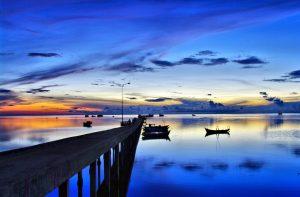
In the fall, you can also visit the mountains to see the prosperity of harvest season in Mu Cang Chai, Y Ty, or Hoang Su Phi. The terraced rice fields turn gold in the sunshine, H’mong women dressed in colourful clothing cheerfully collect their harvest and thresh the rice. You’ll forget the time watching this, soaking in the scent of new rice. For thousands of years, the ethnic peoples of H’mong, Dao and La Chi tribes have planted and harvested rice here, creating the unique and beautiful landscape on the mountains.
In the South, Dalat in the fall is also a must-visit destination. Miles of pine trees adorn the golden sunflowers on the streets of Dalat. Mimosas shyly bloom. The Valley of Love is filled with colourful flowers, or visit Trai Mat Village on a vintage train. Autumn is rainy season here, but the quick showers in this dreamy land always surprise and delight visitors. In the cold and fog, enjoy a warm coffee by a lakeside café by Xuan Huong Lake and admire the cherry blossom flowers and you’ll forget all the problems in life.
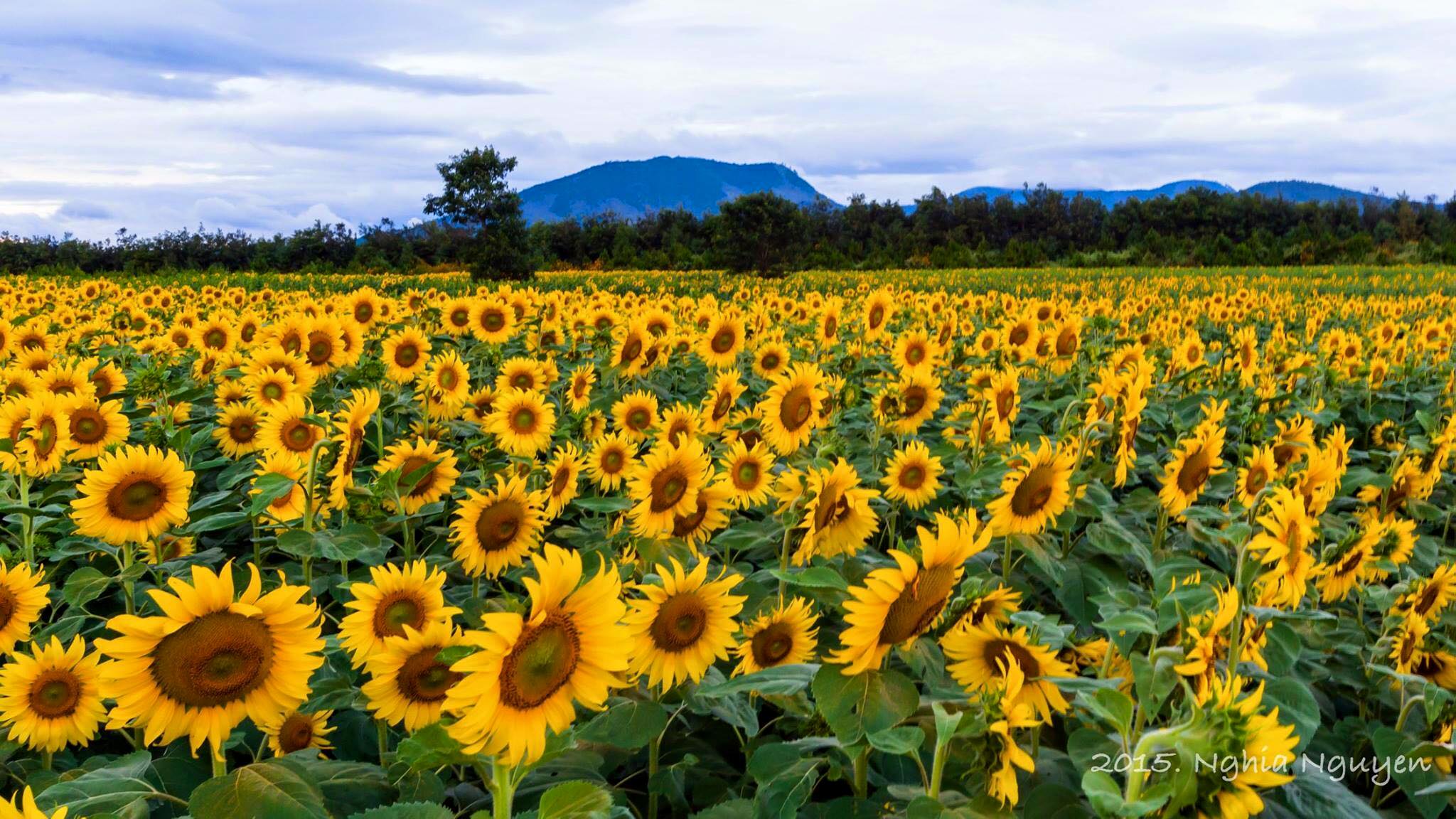
Tips: Golden autumn in the Northwest (Mu Cang Chai, Y Ty, Sapa)
+ Itinerary: Hanoi – Thanh Son – Van Chan – Tu Le – Mu Cang Chai – Hanoi or continue to Than Uyen – Sapa – Y Ty – Lao Cai – Hanoi.
+ Transportation: You can take a motorbike, buses or personal car. It only takes three days to visit Mu Cang Chai, but if you wish to see Y Ty and Sapa, you should plan 4 to 6 days.
+ 3 days in Mu Cang Chai:
♦ Day 1: from Hanoi follow Highway 32 to Thanh Son, check out the tea plantations and then move on to Thu Cuc, passing Khe Mountain Pass to Van Chan. From Van Chan, turn to Suoi Giang (12 kilometres) to enjoy a cup of snow shan tea and the view across huge ancient tea plants. Continue to Nghia Lo and stay overnight at Tu Le Valley (250 kilometres from Hanoi). In Tu Le, there are many hotels, hostels and homestays, and you should make a reservation during harvest season. You should try some specialties here like spring fish, sticky rice, apple cider wine and snake (in Nghia Lo). During your travels, you can also bathe in the hot springs in Hoc Village (Van Chan), Bon Village (Nghia Lo) or Tu Le Town.
♦ Day 2: From Tu Le, continue to Cao Pha Valley to Khau Pha Pass to enjoy the view of the terraced fields in the valley. From there, continue to Kim Junction to reach La Pan Tan Kim, Che Cu Nha. These have the most beautiful view of the terraced fields, located about 300 metres from Ba Nha Bridge. You can walk or take a motorbike taxi from the bridge. Return to Nghia Lo to stay the night.
♦ Day 3: Nghia Lo to Hanoi (about 210 kilometres).
If you only have two days, on the first day you should go to Mu Cang Chai and stay the night there, and return on the second day, the total distance (both ways) is about 600 kilometres. Mu Cang Chai has many hotels and hostels but you will need to make a reservation in advance.
+ 4 days in Mu Cang Chai – Sapa – Y Ty – Lao Cai:
♦ Day 1: Hanoi – Tu Le, following the above itinerary.
♦ Day 2: Tu Le – Khau Pha – La Pan Tan – Mu Cang Chai – Than Uyen – O Quy Ho – Sapa. In the morning, visit the rice fields in Cao Pha, Mu Cang Chai and then continue to Than Uyen, watch the sunset on O Quy Ho Pass and stay the night in Sapa. At night, you can take a walk around Sapa and enjoy roasted chestnuts, salmon, chicken, roasted eggs, horsemeat stew and rice wine.
♦ Day 3: If this is your first time in Sapa, you can spend day 3 visiting a lot of attractions here such as Ta Van, Ta Phin, Muong Hoa Valley, Silver Falls, Ham Rong Mountain, or take the cable car to Fansipan. If not, you can spend the morning visiting the Muon Hoa Fields and capture the beautiful view. After lunch, you can leave for Y Ty following Can Quy Ho Mountain Pass to reach Muong Hum, and stay the night in Y Ty.
♦ Day 4: Y Ty – A Mu Sung – Lung Po – Lao Cai – Hanoi. On the journey from Y Ty to A Lu, A Mu Sung to Lung Po, there are many mountains dyed gold by the harvest. You should see where the Red River enters Vietnam before returning to Lao Cai and following the Highway to reach Hanoi (if you’re travelling by car) or catch a bus or train to Hanoi. If you’re driving a motorbike, you can stay the night in Lao Cai or Yen Bai.
This is the shortest and fastest route to discover the golden autumn in the Northwest. If you have time, you can stay longer in Mu Cang Chai, Sapa, Y Ty or continue to visit Hoang Su Phi and Ha Giang to enjoy the beautiful autumn in the idyllic Northern mountains.
Winter
Travelling cross-country in the winter is the best way to experience all the tastes and colours of the tropics. From the frosty Sapa or Mau Son, to the cool weather in Central Vietnam, the cool temperature is ideal for a walk on the streets of Hoi An. If you want something new, bathe in the hot springs in Le Thuy, Quang Vinh among the pristine forests. Manipulating the currents of the hot Ban Stream and the cool Ban Stream created the hot spring bath. The temperature of the bath ranges from 40 to 45 degrees Celsius and is suitable for bathing, relaxing and healing.
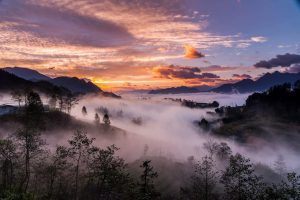
Following the sunny coastal roads of Central Vietnam, visit magnificent Saigon before heading to the Mekong Delta in the West. If you don’t like the cold, this is the perfect destination to travel along the rivers and experience the local culture. The flood season here is famous for specialties like mud carp, river hemp, or dozens of fresh fruits. “Winter” here lasts from December to January and is filled with colourful flowers.
Around Lunar New Year, visit Sadec City (Dong Thap) and buy some flowers from the boats along the Tien River. This charming riverside city is decorated with fields of flowers, blooming just in time for Tet. Following the small roads, you can enjoy some specialities, or you can visit the house of “The Lover” Huynh Thuy Le to learn about the love story between a French girl and a Sadec boy nearly a century ago. This story was adapted into the film “L’Amant”, which won many international awards. Don’t forget to visit the tangerine-farming region of Lai Vung, dubbed ‘the kingdom of tangerines’ and take a walk in a tangerine garden, or travel on a small boat along the river, decorated with ripe tangerines.
Between Dong Thap to Kien Giang, visit Ta Pa Lake or pass U Minh Forest to reach Ca Mau Cape – the country’s Southernmost region. This will surely be a warm winter if you travel by boat along the Mekong Delta, visit the floating market, enjoy local specialties and listen to traditional music.
Time doesn’t wait for anyone, you won’t be young a second time. But you can enjoy life by travelling every season because to travel is to be alive.
Tips: Enjoy winter among the flowers of Sadec and the tangerines in Lai Vung
+ Time: The best time to visit this area is from mid-December to January. During this time, local families decorate their homes with flowers, so the scenery will be beautiful. Everything will be decorated with colourful flowers, and you can buy flowers from boats travelling along the river.
+ Transportation: From Saigon, follow Highway 1A, pass My Thuan Bridge and turn to Sadec District (around 130 kilometres). From other locales, you can fly to Can Tho or Saigon, then travel to Western Provinces, including Dong Thap. The largest flower garden in Sadec District is located in Tan Quy Dong Village by Tien River, located about 5 kilometres from the city centre. You can get there by bus, and then rent a motorbike to get around. After visiting the flower gardens in Sadec, you can head to the ‘tangerine paradise’ Lai Vung via Vam Cong Ferry, or visit Hong Ngu and other places.
+ Accommodation: Sadec, Can Tho and Cai Be have many hotels, hostels, and homestays.
+ Specialties include noodles, thick noodle soup, crab hot pot, beef, noodles with meat sauce, snails and seafood, fresh fruits, Lai Vung spring rolls and Sa Giang chips.
+ 3 days in Sadec
♦ Day 1: Saigon – Cai Be, visit Cai Be’s floating market and islands, visit coconut candy, tea and handicraft makers, and local gardens. Travel to Sadec and spend the night there.
♦ Day 2: Visit the flower village in Sadec, Huynh Thuy Le Ancient House (as seen in the film The Lover), visit the flower gardens on the way to Lai Vung.
♦ Day 3: Visit Lai Vung’s tangerine gardens and return to Saigon, or visit Can Tho, Kien Giang, An Giang, Ca Mau.
Source: Wanderlust Tips


